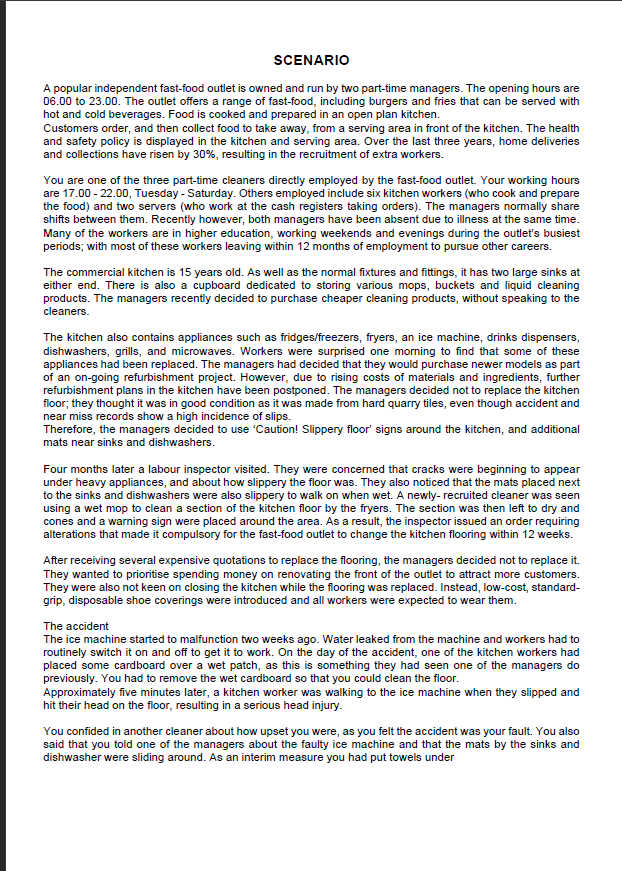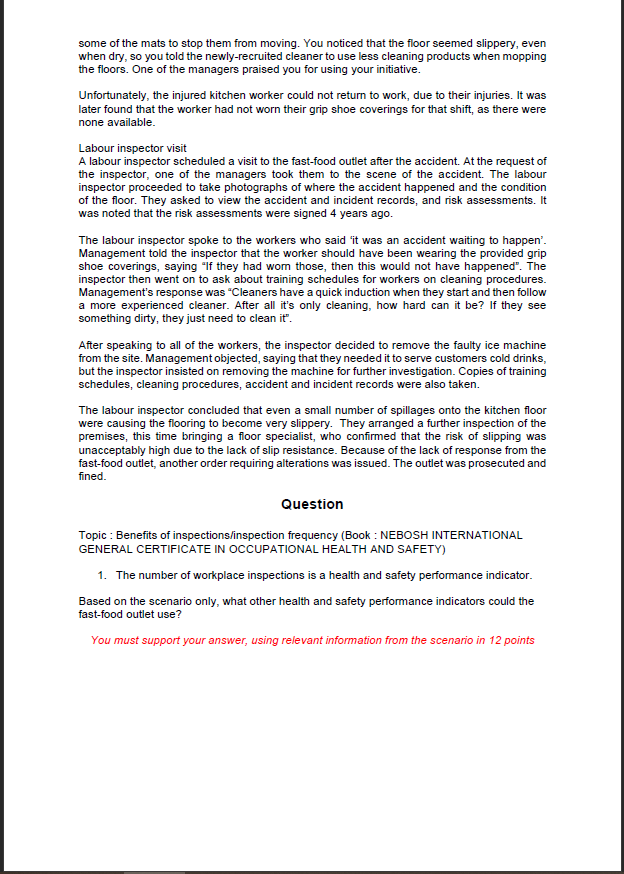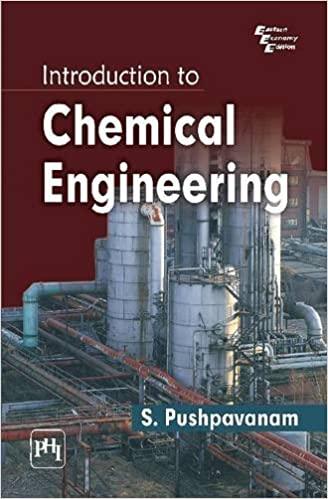Question
SCENARIO A popular independent fast-food outlet is owned and run by two part-time managers. The opening hours are 06.00 to 23.00. The outlet offers a


SCENARIO
A popular independent fast-food outlet is owned and run by two part-time managers. The opening hours are 06.00 to 23.00. The outlet offers a range of fast-food, including burgers and fries that can be served with hot and cold beverages. Food is cooked and prepared in an open plan kitchen.
Customers order, and then collect food to take away, from a serving area in front of the kitchen. The health and safety policy is displayed in the kitchen and serving area. Over the last three years, home deliveries and collections have risen by 30%, resulting in the recruitment of extra workers.
You are one of the three part-time cleaners directly employed by the fast-food outlet. Your working hours are 17.00 - 22.00, Tuesday - Saturday. Others employed include six kitchen workers (who cook and prepare the food) and two servers (who work at the cash registers taking orders). The managers normally share shifts between them. Recently however, both managers have been absent due to illness at the same time. Many of the workers are in higher education, working weekends and evenings during the outlets busiest periods; with most of these workers leaving within 12 months of employment to pursue other careers.
The commercial kitchen is 15 years old. As well as the normal fixtures and fittings, it has two large sinks at either end. There is also a cupboard dedicated to storing various mops, buckets and liquid cleaning products. The managers recently decided to purchase cheaper cleaning products, without speaking to the cleaners.
The kitchen also contains appliances such as fridges/freezers, fryers, an ice machine, drinks dispensers, dishwashers, grills, and microwaves. Workers were surprised one morning to find that some of these appliances had been replaced. The managers had decided that they would purchase newer models as part of an on-going refurbishment project. However, due to rising costs of materials and ingredients, further refurbishment plans in the kitchen have been postponed. The managers decided not to replace the kitchen floor; they thought it was in good condition as it was made from hard quarry tiles, even though accident and near miss records show a high incidence of slips.
Therefore, the managers decided to use Caution! Slippery floor signs around the kitchen, and additional mats near sinks and dishwashers.
Four months later a labour inspector visited. They were concerned that cracks were beginning to appear under heavy appliances, and about how slippery the floor was. They also noticed that the mats placed next to the sinks and dishwashers were also slippery to walk on when wet. A newly- recruited cleaner was seen using a wet mop to clean a section of the kitchen floor by the fryers. The section was then left to dry and cones and a warning sign were placed around the area. As a result, the inspector issued an order requiring alterations that made it compulsory for the fast-food outlet to change the kitchen flooring within 12 weeks.
After receiving several expensive quotations to replace the flooring, the managers decided not to replace it. They wanted to prioritise spending money on renovating the front of the outlet to attract more customers. They were also not keen on closing the kitchen while the flooring was replaced. Instead, low-cost, standard-grip, disposable shoe coverings were introduced and all workers were expected to wear them.
The accident
The ice machine started to malfunction two weeks ago. Water leaked from the machine and workers had to routinely switch it on and off to get it to work. On the day of the accident, one of the kitchen workers had placed some cardboard over a wet patch, as this is something they had seen one of the managers do previously. You had to remove the wet cardboard so that you could clean the floor.
Approximately five minutes later, a kitchen worker was walking to the ice machine when they slipped and hit their head on the floor, resulting in a serious head injury.
You confided in another cleaner about how upset you were, as you felt the accident was your fault. You also said that you told one of the managers about the faulty ice machine and that the mats by the sinks and dishwasher were sliding around. As an interim measure you had put towels under
some of the mats to stop them from moving. You noticed that the floor seemed slippery, even when dry, so you told the newly-recruited cleaner to use less cleaning products when mopping the floors. One of the managers praised you for using your initiative.
Unfortunately, the injured kitchen worker could not return to work, due to their injuries. It was later found that the worker had not worn their grip shoe coverings for that shift, as there were none available.
Labour inspector visit
A labour inspector scheduled a visit to the fast-food outlet after the accident. At the request of the inspector, one of the managers took them to the scene of the accident. The labour inspector proceeded to take photographs of where the accident happened and the condition of the floor. They asked to view the accident and incident records, and risk assessments. It was noted that the risk assessments were signed 4 years ago.
The labour inspector spoke to the workers who said it was an accident waiting to happen. Management told the inspector that the worker should have been wearing the provided grip shoe coverings, saying If they had worn those, then this would not have happened. The inspector then went on to ask about training schedules for workers on cleaning procedures. Managements response was Cleaners have a quick induction when they start and then follow a more experienced cleaner. After all its only cleaning, how hard can it be? If they see something dirty, they just need to clean it.
After speaking to all of the workers, the inspector decided to remove the faulty ice machine from the site. Management objected, saying that they needed it to serve customers cold drinks, but the inspector insisted on removing the machine for further investigation. Copies of training schedules, cleaning procedures, accident and incident records were also taken.
The labour inspector concluded that even a small number of spillages onto the kitchen floor were causing the flooring to become very slippery. They arranged a further inspection of the premises, this time bringing a floor specialist, who confirmed that the risk of slipping was unacceptably high due to the lack of slip resistance. Because of the lack of response from the fast-food outlet, another order requiring alterations was issued. The outlet was prosecuted and fined.
Question
Topic : Benefits of inspections/inspection frequency (Book : NEBOSH INTERNATIONAL GENERAL CERTIFICATE IN OCCUPATIONAL HEALTH AND SAFETY)
- The number of workplace inspections is a health and safety performance indicator.
Based on the scenario only, what other health and safety performance indicators could the fast-food outlet use?
You must support your answer, using relevant information from the scenario in 12 points
SCENARIO A popular independent fast-food outlet is owned and run by two part-time managers. The opening hours are 06.00 to 23.00 . The outlet offers a range of fast-food, including burgers and fries that can be served with hot and cold beverages. Food is cooked and prepared in an open plan kitchen. Customers order, and then collect food to take away, from a serving area in front of the kitchen. The health and safety policy is displayed in the kitchen and serving area. Over the last three years, home deliveries and collections have risen by 30%, resulting in the recruitment of extra workers. You are one of the three part-time cleaners directly employed by the fast-food outlet. Your working hours are 17.00 - 22.00, Tuesday - Saturday. Others employed include six kitchen workers (who cook and prepare the food) and two servers (who work at the cash registers taking orders). The managers normally share shifts between them. Recently however, both managers have been absent due to illness at the same time. Many of the workers are in higher education, working weekends and evenings during the outlet's busiest periods; with most of these workers leaving within 12 months of employment to pursue other careers. The commercial kitchen is 15 years old. As well as the normal fixtures and fittings, it has two large sinks at either end. There is also a cupboard dedicated to storing various mops, buckets and liquid cleaning products. The managers recently decided to purchase cheaper cleaning products, without speaking to the cleaners. The kitchen also contains appliances such as fridges/freezers, fryers, an ice machine, drinks dispensers, dishwashers, grills, and microwaves. Workers were surprised one morning to find that some of these appliances had been replaced. The managers had decided that they would purchase newer models as part of an on-going refurbishment project. However, due to rising costs of materials and ingredients, further refurbishment plans in the kitchen have been postponed. The managers decided not to replace the kitchen floor; they thought it was in good condition as it was made from hard quarry tiles, even though accident and near miss records show a high incidence of slips. Therefore, the managers decided to use 'Caution! Slippery floor' signs around the kitchen, and additional mats near sinks and dishwashers. Four months later a labour inspector visited. They were concerned that cracks were beginning to appear under heavy appliances, and about how slippery the floor was. They also noticed that the mats placed next to the sinks and dishwashers were also slippery to walk on when wet. A newly- recruited cleaner was seen using a wet mop to clean a section of the kitchen floor by the fryers. The section was then left to dry and cones and a warning sign were placed around the area. As a result, the inspector issued an order requiring alterations that made it compulsory for the fast-food outlet to change the kitchen flooring within 12 weeks. After receiving several expensive quotations to replace the flooring, the managers decided not to replace it. They wanted to prioritise spending money on renovating the front of the outlet to attract more customers. They were also not keen on closing the kitchen while the flooring was replaced. Instead, low-cost, standardgrip, disposable shoe coverings were introduced and all workers were expected to wear them. The accident The ice machine started to malfunction two weeks ago. Water leaked from the machine and workers had to routinely switch it on and off to get it to work. On the day of the accident, one of the kitchen workers had placed some cardboard over a wet patch, as this is something they had seen one of the managers do previously. You had to remove the wet cardboard so that you could clean the floor. Approximately five minutes later, a kitchen worker was walking to the ice machine when they slipped and hit their head on the floor, resulting in a serious head injury. You confided in another cleaner about how upset you were, as you felt the accident was your fault. You also said that you told one of the managers about the faulty ice machine and that the mats by the sinks and dishwasher were sliding around. As an interim measure you had put towels under some of the mats to stop them from moving. You noticed that the floor seemed slippery, even when dry, so you told the newly-recruited cleaner to use less cleaning products when mopping the floors. One of the managers praised you for using your initiative. Unfortunately, the injured kitchen worker could not return to work, due to their injuries. It was later found that the worker had not worn their grip shoe coverings for that shift, as there were none available. Labour inspector visit A labour inspector scheduled a visit to the fast-food outlet after the accident. At the request of the inspector, one of the managers took them to the scene of the accident. The labour inspector proceeded to take photographs of where the accident happened and the condition of the floor. They asked to view the accident and incident records, and risk assessments. It was noted that the risk assessments were signed 4 years ago. The labour inspector spoke to the workers who said 'it was an accident waiting to happen'. Management told the inspector that the worker should have been wearing the provided grip shoe coverings, saying "If they had wom those, then this would not have happened". The inspector then went on to ask about training schedules for workers on cleaning procedures. Management's response was a Cleaners have a quick induction when they start and then follow a more experienced cleaner. After all it's only cleaning, how hard can it be? If they see something dirty, they just need to clean it". After speaking to all of the workers, the inspector decided to remove the faulty ice machine from the site. Management objected, saying that they needed it to serve customers cold drinks, but the inspector insisted on removing the machine for further investigation. Copies of training schedules, cleaning procedures, accident and incident records were also taken. The labour inspector concluded that even a small number of spillages onto the kitchen floor were causing the flooring to become very slippery. They arranged a further inspection of the premises, this time bringing a floor specialist, who confirmed that the risk of slipping was unacceptably high due to the lack of slip resistance. Because of the lack of response from the fast-food outlet, another order requiring alterations was issued. The outlet was prosecuted and fined. Question Topic : Benefits of inspections/inspection frequency (Book: NEBOSH INTERNATIONAL GENERAL CERTIFICATE IN OCCUPATIONAL HEALTH AND SAFETY) 1. The number of workplace inspections is a health and safety performance indicator. Based on the scenario only, what other health and safety performance indicators could the fast-food outlet use? You must support your answer, using relevant information from the scenario in 12 pointsStep by Step Solution
There are 3 Steps involved in it
Step: 1

Get Instant Access to Expert-Tailored Solutions
See step-by-step solutions with expert insights and AI powered tools for academic success
Step: 2

Step: 3

Ace Your Homework with AI
Get the answers you need in no time with our AI-driven, step-by-step assistance
Get Started


